Eighteenth Century Hydrostatic Bubbles By Gardner & Laurie Glasgow

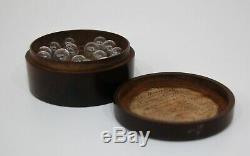
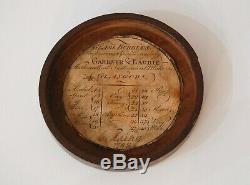
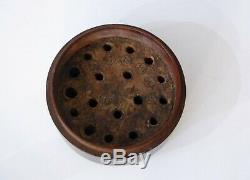
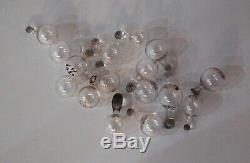
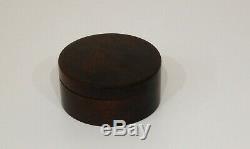

For sale a very rare set of eighteenth century hydrostatic bubbles by Gardner & Laurie, Glasgow. The early forefather of the more widely known Sikes hydrometer, these interesting instruments are also known as philosophical bubbles, specific gravity beads, aerometrical beads or hydrostatic beads.
A contemporary biographical account of Wilsons life relates that in 1757. He invented the hydrostatical glass-bubbles, for determining the strength of spirituous liquors of all kinds, which long experience, especially among the distillers and merchant in the West Indies, has now shown to be more accurate and more commodious than the instruments formerly used. From the minutes of a Philosophical and Literary Society, composed of the Professors and some of their friends, whose meetings were held weekly in the college, it appears that these hydrostatical bubbles made the subject of a discourse delivered by Wilson in 1757. At this time he also showed how a single glass bubble may serve for estimating very small differences of specific gravity of fluids of the same kind, such as water taken from different springs, or the like.
This he did by varying the temperature of such fluids, till the same bubble, when immersed, became stationary at every trial, and then expressing the differences of their specific gravity, by degrees of the thermometer, the value of which can be computed and stated in the usual manner. This particular set of hydrostatic bubbles is comprised of a turned mahogany case with a diameter of three and a quarter inches. The removal of the lid reveals a set of 16 glass bubbles and 18 holes (two bubbles are missing) with a paper label denoting a number for each hole which relates to a specific size glass bubble. The glass bubbles themselves consist of a bulb end with differing sizes of glass stalk and a corresponding number engraved to the top.
The lid has its original paper label stating. Glass Bubbles for proving spirits, made by Gardner & Laurie, Mathematical Instrument Makers, Glasgow. It contains a further list of numbers (relating to the bubbles) and states the type of liquid that the specific bubble is expected to identify. This list contains, alcohol, spirit of wine, high wines, very strong, oil of olive, proof, flowers and very weak.It also has the name of C. Laing and the date 1793 written in pen and ink onto the trade card. It is somewhat rare to find an example of these glass bubbles in sensible condition but it is terrifically rare to find a set made by the maker Gardner & Laurie as this Glaswegian business only existed from 1792 to 1798. The company traces its roots back to the very place where this instrument was originally conceived at Glasgow University and with the more famous Scottish figure of James Watt, steam engine engineer and inventor.
Watt after undertaking his apprenticeship, set up business in 1757 (the same year as the invention) at Glasgow University and provided instruments to the institution so it is likely that Watt himself produced earlier examples. The death of Watts wife in 1773 precipitated his move away from Glasgow to Birmingham and by 1773, Gardner is known to have been trading under his own account by this point.
It must also be presumed that Gardner himself must have learnt surveying skills through Watts guidance as he was appointed in 1789 as assistant to James Barry, Glasgow land surveyor and succeeded him to this post following Barries death in 1792. It is likely that Gardners partnership with James Laurie coincided with Gardners increasing workload and the departure of his previous partner James Sym. Little is known of James Laurie as he seems not to have worked as an independent scientific instrument maker but during the six years of their partnership they advertised a wide range of products. In 1799, Gardner entered into a new partnership with his son John Gardner and the company was renamed to J&J Gardner. In 1818 the son John Gardner died in the middle of bankruptcy proceedings for the company and amongst the creditors were Thomas Jones of Charing Cross, which perhaps gives a flavour of the circles within which they were trading at the time. It did however manage to continue trading and by the time of John Gardners death in 1822 there existed a partnership named, Gardner, Jamieson & Co.The family dynasty did not disappear upon John Gardners death, it was initially continued by his wife Margaret and his younger son but finally became Gardner & Co and under that title remained in business until circa 1920. It is of further interest to note that bankruptcy proceedings dogged the family after John Gardners death and in 1832 one of the creditors is listed as Laurie & Hamilton, Glasgow Merchants. Perhaps a common Scottish surname but could it have been the same Laurie from the earlier parternship. Further research may well bring that question to conclusion.
There is only one other documented scientific instrument recorded by this company, an octant in the Frank Collection. A rare and highly important piece of scientific history dated from the first year of this short lived partnership. Jason Clarke Antiques are happy to discuss carriage, condition or for any other queries, alternatively, you can also message me and I will endeavour to come back to you as soon as possible. I have a number of beautiful antiques for sale, so please feel free to browse my other items.The item "EIGHTEENTH CENTURY HYDROSTATIC BUBBLES BY GARDNER & LAURIE GLASGOW" is in sale since Saturday, March 16, 2019. This item is in the category "Antiques\Science/Medicine\Scientific Instruments". The seller is "jason750_1" and is located in newbury, Berkshire. This item can be shipped to United Kingdom.
- Period: Pre 1800
- Material: Glass
- Type: Hydrometer

